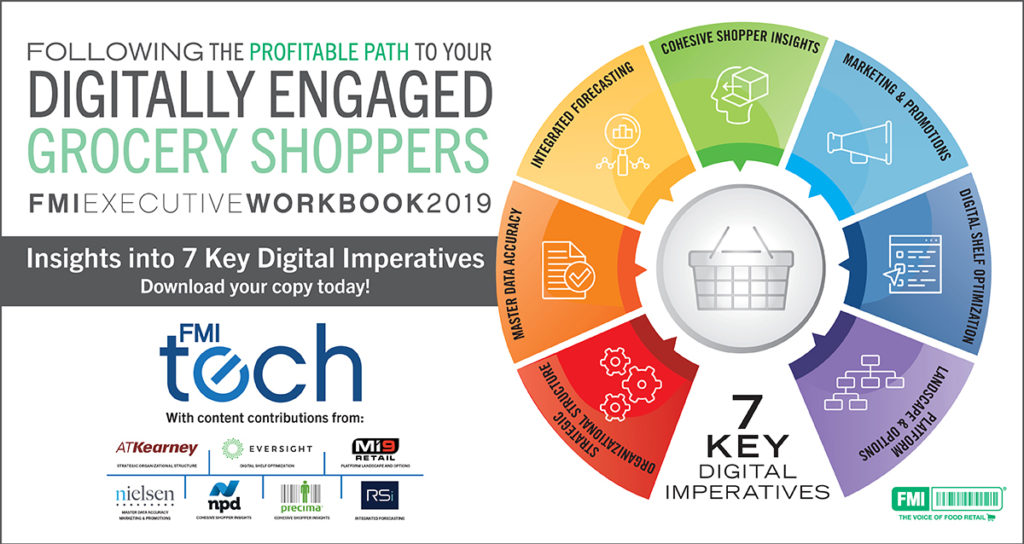FMI Executive Workbook 2019

Excerpt from the workbook:
How to Maximize Your Omnichannel Sales and Profits by Developing an Integrated Forecasting and Fulfillment Model
In the relatively recent past, the majority of shopping was still done in-store (bricks-and-mortar). However, with the rapid rise of e-commerce and the increasing dominance of smartphones and other mobile devices in driving online shopping growth, consumers now demand the convenience of shopping how, when, and through the channel they choose. This growing omnichannel shift is both a challenge and an opportunity for the global retail industry. Retailers and CPG manufacturers alike can maximize their growth and profitability by embracing the growing omnichannel imperative and making it a key part of their business strategy and operational approach.
The good news is that the retail industry is responding to these changing consumer shopping trends in profitable new ways. The bad news is that these shifts are creating availability challenges that can lead to lost sales and shopper dissatisfaction:
- Retailers pushing towards even greater in-store fulfillment
›› Sub-case quantities
›› Mixed item/mixed temperature baskets
›› Purchases delivered by third-party providers
›› “Click and collect” purchases - Online and in-store shoppers competing for the same inventory
- Exacerbating out-of-stock (OOS) issues, resulting in lost sales
How the Omnichannel Shift is Creating a Second “Showtime” Challenge for CPGs and Retailers
Traditionally, grocery retailers have had to deal with a daily “showtime,” which is when the store experiences its biggest rush of shoppers. But, with the explosive growth in online shopping, grocery retailers and their CPG suppliers must now grapple with a second “showtime” every day. Typically in the morning, the new omnichannel “showtime” happens when store employees fulfill the growing volume of online orders generated by “click and collect.” Because the store inventory usually is not decremented until after the order is placed and paid for, the new omnichannel-driven “showtime” can create serious out-of-stocks (OOS) issues, which lead to unhappy consumers and lost sales. This creates new pressure to ensure that in-store shoppers don’t encounter OOS on their preferred items during the traditional afternoon “showtime.”
Capitalizing on the Growing “Showtime” Opportunity
To fully capitalize on the growing omnichannel “showtime” opportunity and make “click and collect” a winner for consumers and retailers’ bottom-line, retailers will need to implement an integrated data management and forecasting/fulfillment model—and the technology already exists for such a system.
Today, retailers and CPG manufacturers can optimize their business across every channel, from in-store purchases, to e-commerce, to “click and collect.” With the new state-of-the-art data forecasting, analytics and reporting solutions, the retail industry now has the visibility, agility and intelligence it needs to dynamically manage the omnichannel “showtime” every day, leading to increased sales and profits.
In this report we recommend that you adopt an integrated forecasting and fulfillment model and technology system that enables retailers and CPGs to solve the OSA issues posed by the new omnichannel “showtime.” This will ensure that the retail industry delights consumers, no matter which channel they choose for their shopping.
Self Assessment Questions:
- In regards to product availability, specific to omnichannel orders, what is your biggest opportunity—getting products into the right stores, at the right time and quantity, or getting products into the right distribution centers?
- Do you plan to fulfill at least 50 percent of your on-line orders from in-store inventory? If so, do all of your products have at least 99 percent on-shelf availability at all times?
- Do you decrement your on-line orders from your perpetual inventory in real-time (i.e., when the consumer orders on-line), or do you wait to decrement your perpetual inventory until later in the fulfillment process such as order picking, order payment, or order pick-up?
To read the entire workbook, click here or visit the link below.
source: FMI, https://fmi.org/omnichannel




Leave a Reply
You must be logged in to post a comment.